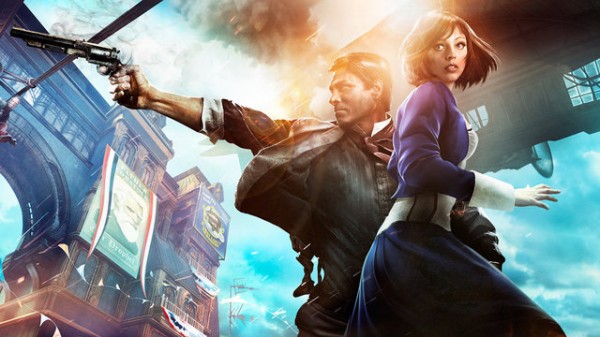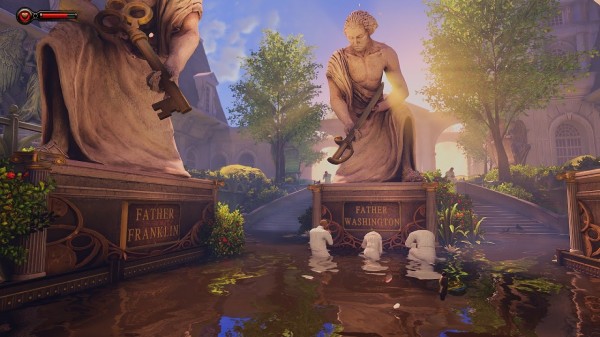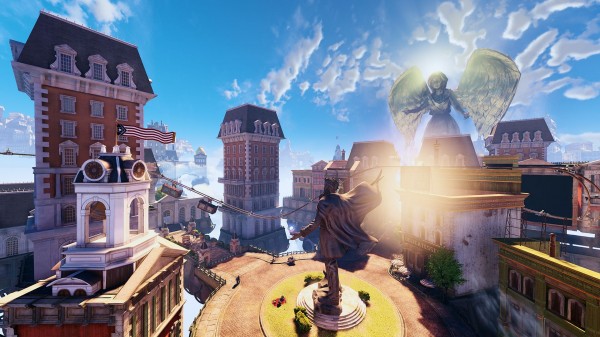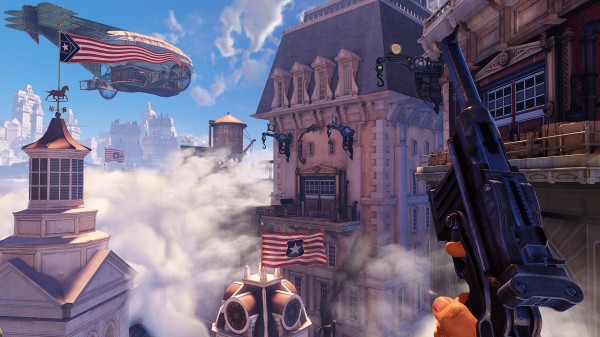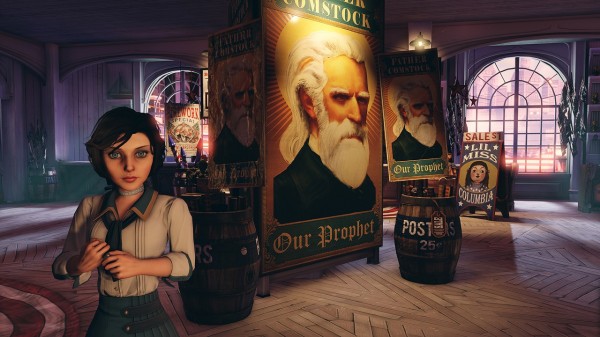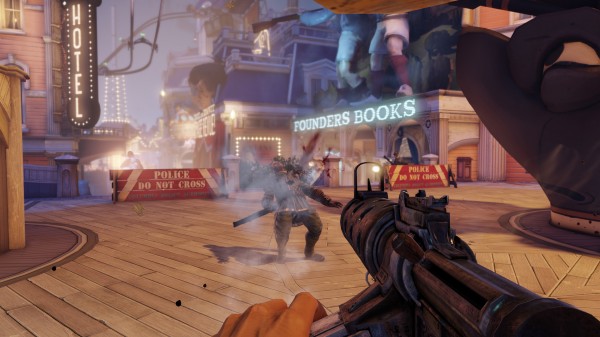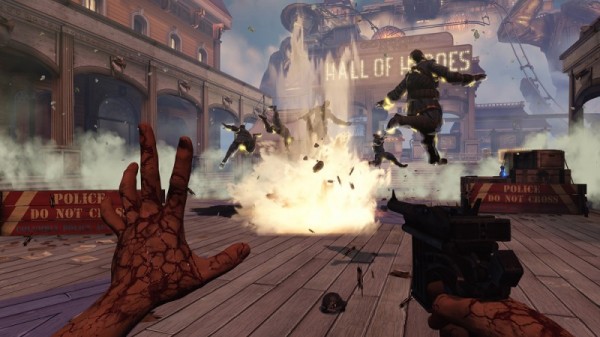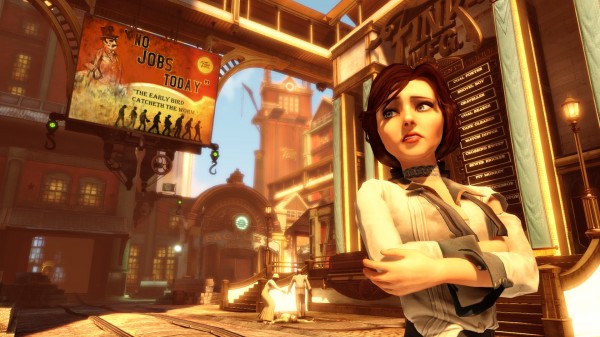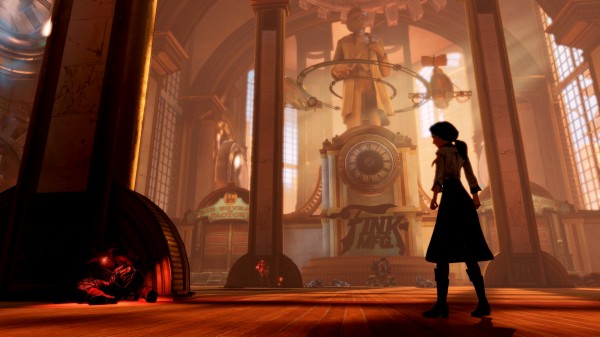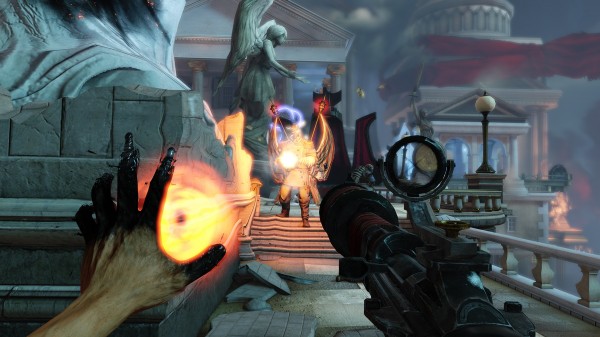Well…that didn’t take long. If you may recall, just a few weeks ago I had called the Tomb Raider reboot my favorite game of the year. It has since been demoted to being my second favorite game of the year. Irrational Games’ BioShock Infinite has eclipsed Lara Croft’s latest offering in virtually every facet.
The story in BioShock Infinite starts in 1912 with Booker DeWitt, a former Pinkerton Agent, being rowed to a lighthouse in the middle of nowhere. He has to enter the floating city of Columbia to find a girl named Elizabeth so he can erase his massive gambling debt. Upon entering Columbia Booker finds himself in a place that looks like heaven, a pristine and gilded city floating in the clouds.
Booker had arrived just in time to partake in a yearly fair that occurs in Columbia, and makes his way to a raffle being held. At the raffle, Booker sees some things from the Columbians that makes him think things in Columbia aren’t as wholesome and clean as they seem on the surface. However, before Booker can to anything about it, some people notice the “AD” branding on his right hand. It turns out that that is the mark of the False Shepherd, a feared figure in Columbia and the local police start attacking him as a result.
After fighting his way through waves of police, Booker makes his way to the tower where Elizabeth is being held and frees her, but not before the duo have to run away from Elizabeth’s guardian, the hulking winged beast called the Songbird. It turns out that Elizabeth has the ability to open “tears” that randomly pop up in Columbia. These tears are portals into different times and places, and Elizabeth’s ability to manipulate them becomes an important part to the plot of the game later on.
The writing and world building in BioShock Infinite is amazing. Booker and Elizabeth shine in their characterization, with the father/daughter-like relationship between the two being a great slowly developed arc. The principal side characters are also really well written, such as the passionate leader of the Vox Populi revolutionary faction, Daisy Fitzroy and the founder of Columbia, Zachary Hale Comstock.
Columbia is a great location filled with 1900s American ideals turned up to the extreme, while also having some unique things to it. For example, the people of Columbia practice a religion that has Comstock as the central figure of it all and George Washington, Benjamin Franklin, and Thomas Jefferson are also deified. There is also a group in Columbia that celebrates John Wilkes Booth for his assassination of Lincoln. Yet despite fantastic displays of racism and jingoism around every corner in Columbia, the society in the city is surprisingly modern in one aspect, gender equality. One example of this is that there are female members of Columbia’s police force.
The gameplay in BioShock Infinite is really fine tuned and an improvement over the previous BioShock titles in most aspects. Booker can use Vigors, various powers that take the place of the series trademark Plasmids. There are eight Vigors to use in total and they all have two functions and some of them can be combined for devastating damage. My personal favorite combination being the Bucking Bronco and Charge, wherein the Bucking Bronco sends enemies flying up into the air and Charge sends Booker flying forward to an enemy to do a massive damage melee attack. However, one aspect that I felt is not an improvement is that you are now restricted to just two guns, which means a lot of weapons won’t even be used by most players once they find their two favorite ones.
Booker can also upgrade his abilities by finding various pieces of clothing called Gear throughout the game’s areas. Gear can give Booker a wide range of new abilities, like a hat that makes his melee attacks set enemies on fire, or a vest that stuns enemies briefly when they hit Booker with a melee attack of their own. The problem is several of the Gear have conditions that are too situational to be really useful. To round out the collectable upgrades, there are Infusions which can be used to increase the size of Booker’s health, shield, or salt meters.
Elizabeth also plays a vital role in BioShock Infinite’s gameplay. She can use her ability to manipulate tears to open up little pocket dimensions that summons things from caches of weapons, health, and salt to automated gun turrets. During the course of combat, Elizabeth will also throw Booker ammo, healing items, and salt replenishing items.
Outside of combat Elizabeth will toss Booker some extra cash that he can use on the game’s vending machines. In addition Elizabeth cannot be harmed in this game, making her without a shadow of a doubt one of the best AI partners in video games to date. The parts of the game where Booker and Elizabeth are separated feel like the game is missing something. Elizabeth’s presence at Booker’s side adds just so much more to the game.
Visually, BioShock Infinite is artistically beautiful, but technically lacking in some areas, a problem similarly shared with last year’s Dishonored. Like Dishonored, Infinite has a stunning art style and level design, but textures can be a bit iffy in several places. In addition there is several NPC models used over and over again even in the same areas just mere feet apart from each other. This has the effect of making the game look like it is filled with clones.
That being said, Irrational Games did an amazing job animating Elizabeth. Her facial animations are very expressive and will change right in front of you, and on top of that she will wonder around doing her own thing if Booker stays in an area for a prolonged period of time. The visual changes the different Vigors have on Booker’s hands are also nicely animated, especially the Bucking Bronco animation which has the flesh on Booker’s hands become cracked and vibrating slightly away from his hand.
Audio wise, there aren’t many games that top Infinite. The voice work all around is some of the best I’ve heard in a game, but Troy Baker and Courtney Draper easily steal the show as Booker DeWitt and Elizabeth. Musically, there is some great song selection. The original tracks made for the game fit each moment perfectly and the combat music is organic, in that it adds in extra sounds each time you get a kill, for instance. The game also incorporates several songs fitting to both the era of the game and from outside of the era, the latter of which the songs are either stolen from tears and reworked into old timey songs or you can hear the actual songs being played from a tear from their respective year of relevance.
BioShock Infinite does very few things wrong, and while the final game is almost nothing like any of the gameplay videos and trailers that have been released for the game since 2010, it is still a great experience. Infinite shows exactly why single player-only experiences are still a very viable option for video games when so much love and care are put into them. I beseech everyone who likes to play video games to somehow find a way to play BioShock Infinite before the year is over. BioShock Infinite is now my new favorite game of the year and any future challengers to its crown will have to be ready to pry it from the game’s cold, dead hands.
BioShock Infinite is rated M for Mature. It was released on March 26th, 2013 for the PS3, Xbox 360, and PC. I played the PS3 version for this review.

